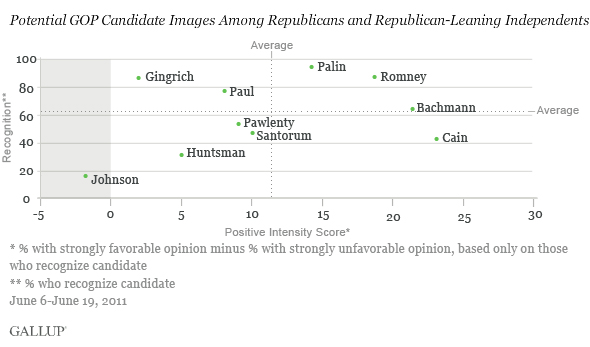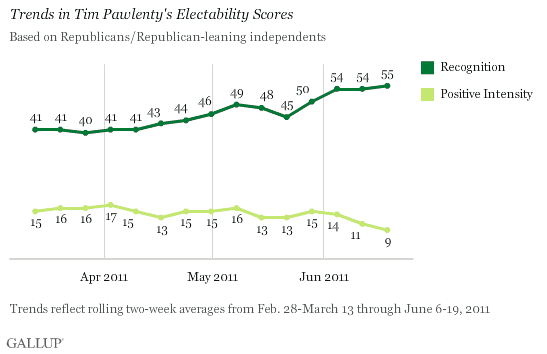PRINCETON, NJ -- Gallup Daily tracking finds no major shake-up in the GOP presidential candidates' ratings among Republicans nationwide in the two weeks surrounding a New Hampshire debate that featured seven of the candidates. Mitt Romney, Sarah Palin, and Michele Bachmann continue to enjoy the best overall positioning by virtue of having higher name recognition and Positive Intensity Scores than their potential rivals. By comparison, Jon Huntsman, who formally announced his candidacy Tuesday, is recognized by 34% of Republicans and enters the race with the third-lowest Positive Intensity Score of any candidate measured.

The June 6-19 field period for these results includes a week of interviewing both before and after the June 13 debate.
Looking at the Gallup candidate performance measures separately reveals that, first, Palin, Romney, Newt Gingrich, Ron Paul, and Bachmann are the most well-known of the 10 Republicans Gallup tracks. Secondly, Herman Cain, Bachmann, Romney, and Palin enjoy the most strongly positive reactions from those who know them, with above-average Positive Intensity Scores (percentage strongly favorable minus percentage strongly unfavorable).
The only significant change this week is a slight drop in Gingrich's Positive Intensity Score to +2 from +4, adding to a steep decline in popularity for the former House speaker since late March/early April, when his score peaked at +19. Gingrich now has the second-lowest score of any Republican tested, ahead of only Gary Johnson.

Additionally, Bachmann's intensity score edged up slightly (from +18 to +22) and Cain's declined slightly (from +28 to +23). Given the sample sizes of Republicans familiar with each candidate (smaller than those familiar with Gingrich), these changes are not statistically significant; however, if they hold for another week, they would represent real shifts after the debate.
More generally, among those with the highest Positive Intensity Scores, Cain is performing better than he did earlier this year, Romney has recovered somewhat from a decline in his ratings in late April and May, and Bachmann is on par with her earlier ratings, while Palin is near her low point for the year.

Huntsman is now known by 34% of Republicans, a marked increase from earlier this year, and potentially headed higher now that he has formally announced his candidacy. At the same time, positive intensity toward him has declined, indicating that he is not attracting the same level of support from Republicans who have newly been introduced to him as he did from those who were familiar with him early on.

Most of the interviewing for the new results was conducted after a June 7 economic address by Tim Pawlenty, a speech many saw as a major attempt by him to break out of the lower-ranked pack of candidates and become more competitive with Romney. However, his personal ratings held fairly steady in the latest polling: his recognition rose by just one percentage point from 54% to 55%, and his Positive Intensity Score dipped slightly from +11 to +9. While these changes are not statistically significant, his +9 intensity score is his lowest to date this year, punctuating three consecutive declines since late May.

Bottom Line
Romney, Palin, and Bachmann continue to fare best among Republicans nationwide by simultaneously being among the best-known names in the potential presidential field as well as generating positive reactions from those familiar with them. This nexus of recognition and popularity will be essential to each candidate's success in the primary elections next year.
Romney, Palin, Gingrich, and Paul all face the difficult challenge of improving their images among Republicans who mostly know them and have already formed opinions about them.
Johnson, Huntsman, and, to a lesser extent, Rick Santorum, Cain, and Pawlenty, all have an arguably more difficult task in needing to expand their name recognition among Republicans at a time when major national press opportunities, such as debates, are still fairly infrequent. Also, because of their lower profiles, these candidates may find that the campaign funds for buying national TV time are hard to come by, a conundrum faced by most second-tier candidates.
Additionally, Gingrich, Pawlenty, and Palin have all experienced declines in popularity at the same time that Romney, Bachmann, and Cain are mostly holding steady.
Survey Methods
Results are based on telephone interviews conducted as part of Gallup Daily tracking June 6-19, 2011, with random samples of Republicans and Republican-leaning independents, aged 18 and older, living in all 50 U.S. states and the District of Columbia. Questions asking about the 10 potential candidates measured in this research were rotated among randomly selected samples of Republicans each night; over the 14-day period, each candidate was rated by a minimum of 1,500 Republicans and Republican-leaning independents.
For the overall ratings of each potential candidate among Republicans and Republican-leaning independents, including recognition scores, one can say with 95% confidence that the maximum margin of sampling error is ±3 percentage points. For the Positive Intensity Score for each candidate, the maximum margin of sampling error varies depending on the size of the group recognizing the candidate.
Interviews are conducted with respondents on landline telephones and cellular phones, with interviews conducted in Spanish for respondents who are primarily Spanish-speaking. Each sample includes a minimum quota of 400 cell phone respondents and 600 landline respondents per 1,000 national adults, with additional minimum quotas among landline respondents for gender within region. Landline telephone numbers are chosen at random among listed telephone numbers. Cell phone numbers are selected using random-digit-dial methods. Landline respondents are chosen at random within each household on the basis of which member had the most recent birthday.
Samples are weighted by gender, age, race, Hispanic ethnicity, education, region, adults in the household, and phone status (cell phone only/landline only/both, cell phone mostly, and having an unlisted landline number). Demographic weighting targets are based on the March 2010 Current Population Survey figures for the aged 18 and older non-institutionalized population living in U.S. telephone households. All reported margins of sampling error include the computed design effects for weighting and sample design.
In addition to sampling error, question wording and practical difficulties in conducting surveys can introduce error or bias into the findings of public opinion polls.
For more details on Gallup's polling methodology, visit www.gallup.com.
